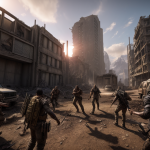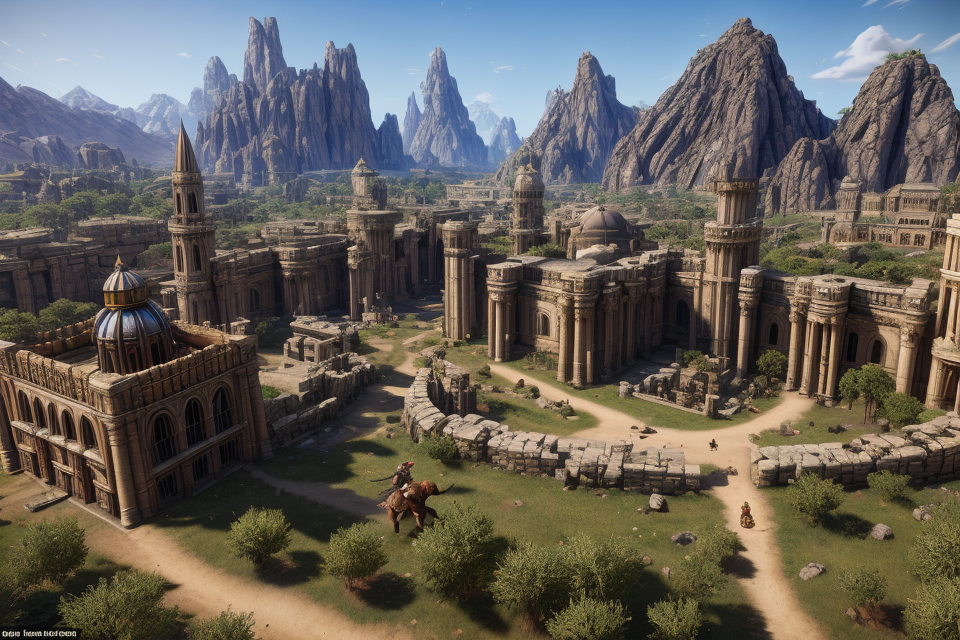The world of gaming is a vast and diverse one, with a seemingly endless array of genres and sub-genres to choose from. But amidst all this variety, one particular type of game has stood out as a perennial favorite among gamers of all ages and backgrounds: the open world RPG. From the sprawling landscapes of Skyrim to the bustling cities of Cyberpunk 2077, these games have captured the hearts and minds of millions, and it’s easy to see why. In this comprehensive exploration, we’ll delve into the many reasons why open world RPGs have become such a staple of the gaming world, and why their enduring appeal shows no signs of waning.
What are Open World RPG Games?
Defining the Genre
- Examining the Roots of Open World RPG Games
- The Evolution of Open World Gaming
- Early Pioneers and Milestones
- Ultima Series
- The Elder Scrolls Series
- Modern Advancements and Innovations
- Skyrim
- Fallout 4
- Early Pioneers and Milestones
- The Evolution of Open World Gaming
- The Distinct Features of Open World RPG Games
- Player Freedom and Exploration
- Sandbox-style Gaming
- Crafting and Survival Elements
- In-depth Character Development and Customization
- RPG Mechanics and Progression Systems
- Skill Trees and Specializations
- Dynamic Worlds and Non-Linear Storytelling
- Side Quests and Optional Content
- Emergent Narratives and Player Choice
- Player Freedom and Exploration
- Understanding the Appeal of Open World RPG Games
- The Desire for Immersion and Exploration
- Escapist Entertainment
- Rich and Detailed Game Worlds
- The Sense of Achievement and Progression
- Leveling Up and Skill Progression
- Collecting and Crafting
- The Allure of Role-Playing and Customization
- Playing as Your Ideal Character
- Tailoring Experiences to Personal Preferences
- The Desire for Immersion and Exploration
Key Characteristics
- Open world design: The game world is vast and seamless, with no invisible walls or barriers to restrict player movement. Players can explore the environment freely, discovering new locations, characters, and quests at their own pace.
- RPG elements: These games often feature a strong emphasis on character development, including leveling up, acquiring new skills and abilities, and customizing characters with a variety of equipment and weapons.
- Narrative depth: Open world RPGs typically have complex and intricate storylines that evolve over the course of the game. Players often encounter a diverse cast of characters, each with their own motivations and agendas, which can impact the story’s direction and outcome.
- Side quests and activities: These games often offer a variety of optional side quests and activities that provide additional challenges and rewards for players to discover. This can include hunting, crafting, trading, and more.
- Non-linear progression: Unlike linear RPGs, open world games often allow players to approach quests and objectives in any order they choose. This creates a sense of freedom and autonomy, allowing players to tailor their gaming experience to their own preferences and playstyle.
The Rise of Open World RPG Games
Historical Overview
The evolution of open world RPG games can be traced back to the early 1980s with the release of the game Ultima III: Exodus. This game introduced the concept of a vast, persistent world that players could explore and interact with. However, it was not until the 1990s that open world RPG games truly gained popularity with the release of games such as Super Mario 64 and The Elder Scrolls III: Morrowind.
Super Mario 64 was a groundbreaking game that introduced 3D gameplay and a large, open world for players to explore. The game’s open world design allowed players to explore different areas and complete objectives in any order they desired. This level of freedom and exploration was a significant departure from previous 2D Mario games and set a new standard for open world game design.
The Elder Scrolls III: Morrowind, released in 2002, was another significant milestone in the evolution of open world RPG games. This game featured a vast, detailed world with a deep lore and history. Players could explore the world, complete quests, and interact with NPCs in a way that felt truly immersive. The game’s focus on player choice and freedom set a new standard for open world RPG games and influenced many of the games that followed.
In the 2000s, open world RPG games continued to gain popularity with the release of games such as Grand Theft Auto III and The Legend of Zelda: Ocarina of Time. These games built on the foundations laid by Super Mario 64 and Morrowind, and further refined the open world RPG formula.
Today, open world RPG games are a staple of the gaming industry and continue to evolve and improve with each new release. From the sprawling world of The Witcher 3 to the post-apocalyptic wasteland of Fallout 4, there is no shortage of open world RPG games for players to enjoy.
Evolution of Gaming Technology
Technological Advancements in Consoles and PCs
The evolution of gaming technology has played a significant role in the rise of open world RPG games. The development of consoles and PCs with more powerful hardware has enabled game designers to create more immersive and expansive gaming environments. The increase in processing power, memory, and storage capacity has allowed for more intricate and detailed game worlds, enhancing the overall gaming experience.
Emergence of 3D Graphics and Improved Animation
The introduction of 3D graphics and improved animation techniques has significantly contributed to the popularity of open world RPG games. The ability to create realistic and dynamic environments with three-dimensional models has allowed players to fully immerse themselves in the game world. This enhanced visual experience has become a hallmark of open world RPG games, making them more appealing to players seeking an engaging and interactive gaming experience.
Integration of Virtual Reality and Augmented Reality Technologies
The integration of virtual reality (VR) and augmented reality (AR) technologies in gaming has further enhanced the appeal of open world RPG games. VR and AR technologies provide players with an even more immersive experience, allowing them to explore game worlds in a more interactive and dynamic manner. These technologies have enabled game designers to create even more realistic and detailed game environments, further enhancing the overall gaming experience for players.
Advances in Artificial Intelligence and Procedural Generation
The advances in artificial intelligence (AI) and procedural generation have also contributed to the rise of open world RPG games. AI technology has enabled the creation of more intelligent and responsive non-player characters (NPCs), enhancing the interactive nature of the game world. Procedural generation, on the other hand, allows for the creation of vast and varied game environments, ensuring that each playthrough of an open world RPG game is unique and engaging.
In conclusion, the evolution of gaming technology has played a significant role in the rise of open world RPG games. The development of more powerful hardware, the emergence of 3D graphics and improved animation, the integration of VR and AR technologies, and the advances in AI and procedural generation have all contributed to the popularity of open world RPG games. These technological advancements have enabled game designers to create more immersive and expansive game worlds, enhancing the overall gaming experience for players.
The Allure of Open World RPG Games
Immersive Gameplay
Exploration and Discovery
One of the key factors contributing to the immersive gameplay of open world RPG games is the opportunity for exploration and discovery. These games offer vast and intricately designed worlds, teeming with secrets, hidden treasures, and untold stories, which encourage players to venture off the beaten path and explore uncharted territories. The sense of wonder and anticipation that comes with stumbling upon a hidden cave, ancient ruin, or treasure-filled dungeon adds an extra layer of excitement and immersion to the overall gaming experience.
Dynamic Environments and Events
Open world RPG games also provide dynamic environments and events that respond to the player’s actions and decisions, enhancing the immersive gameplay. These environments offer a sense of living, breathing worlds where the player’s actions have consequences and can shape the game’s narrative and outcome. Dynamic events, such as natural disasters, invasions, or character interactions, create a sense of unpredictability and urgency, making the player feel like they are part of a larger, living world.
Player Agency and Choice
Open world RPG games often provide players with a high degree of agency and choice, allowing them to shape their character’s progression, interactions, and story arc. This level of customization and player involvement fosters a strong sense of investment and attachment to the game world, making the experience feel more immersive and personal. By offering multiple paths, dialogue options, and character development choices, players can tailor their gameplay experience to align with their individual playstyle and preferences, further enhancing the immersive nature of the game.
Immersive Storytelling and Characters
Open world RPG games often feature rich and detailed narratives, complete with complex characters, intricate storylines, and emotional arcs. These stories are often told through a combination of dialogue, cutscenes, and player-driven interactions, allowing players to form connections with the characters and become invested in their struggles and triumphs. By offering well-developed and dynamic characters, these games create an immersive experience that transcends gameplay mechanics and delves into the realm of storytelling, allowing players to become fully engrossed in the game’s world and narrative.
Overall, the immersive gameplay of open world RPG games is a crucial aspect of their enduring appeal. By offering vast and intricately designed worlds, dynamic environments and events, player agency and choice, and immersive storytelling and characters, these games transport players to new realms of imagination and adventure, creating an unparalleled gaming experience that continues to captivate and inspire gamers worldwide.
Freedom of Choice
One of the primary reasons why open world RPG games continue to captivate players is the freedom of choice they offer. This freedom allows players to shape their own gaming experience, creating a personalized journey that is tailored to their preferences. Here are some key aspects of the freedom of choice in open world RPG games:
Customizable Character Progression
In open world RPG games, players can choose how they want to develop their characters. They can allocate skill points, select specific abilities, and choose the equipment that best suits their playstyle. This level of customization enables players to create a unique character that aligns with their preferences, making the gaming experience more engaging and enjoyable.
Multiple Paths and Approaches
Open world RPG games often offer multiple paths and approaches to completing objectives, allowing players to choose the most suitable route for their playstyle. For example, they may opt for a stealthy approach, avoiding direct combat, or choose to engage in fierce battles. This flexibility encourages players to think creatively and strategically, catering to their individual preferences and fostering a sense of achievement.
Dynamic Questing and Side Content
Open world RPG games often feature a vast array of quests and side content, which players can choose to pursue or ignore. This variety allows players to tailor their gaming experience to their interests, exploring different aspects of the game world at their own pace. For instance, they may choose to focus on the main storyline, or they may delve into the rich tapestry of side quests and activities. This freedom to choose adds an extra layer of excitement and immersion to the game.
Non-Linear Storytelling
Open world RPG games often incorporate non-linear storytelling, enabling players to explore the game’s narrative at their own pace and in whichever order they prefer. This non-linear approach can create a more engaging and immersive experience, as players can piece together the story fragments they encounter and form their own understanding of the game’s world and characters. It also allows players to revisit previous areas and complete additional quests or tasks, adding depth and replayability to the game.
By offering players the freedom of choice, open world RPG games provide an experience that caters to individual preferences and encourages exploration, experimentation, and creativity. This freedom to shape one’s own journey within the game world is a significant contributor to the enduring appeal of open world RPG games.
Character Development
One of the primary reasons why open world RPG games are so captivating is the opportunity for extensive character development. In these games, players can create and customize their characters, often choosing from a variety of races, classes, and skills. This customization allows players to create a unique avatar that reflects their personal gaming style and preferences.
Furthermore, character development in open world RPG games goes beyond just creating a visually appealing avatar. Players can also shape their characters’ personalities, abilities, and relationships with other characters throughout the game. For example, players can choose to make their character a skilled warrior, a cunning thief, or a charismatic leader, each with their own set of strengths and weaknesses.
As players progress through the game, they can level up their characters, earn new abilities and equipment, and unlock new skills and spells. This constant progression allows players to continually customize and improve their characters, ensuring that they remain relevant and effective throughout the game.
In addition to character development, open world RPG games often feature a diverse cast of NPCs (non-playable characters) with their own unique personalities and storylines. Players can interact with these characters in various ways, such as forming alliances, completing quests, or engaging in combat. These interactions can have a significant impact on the game’s story and the development of the player’s character.
Overall, the extensive character development options in open world RPG games provide players with a sense of ownership and investment in their characters. This sense of ownership encourages players to become deeply engaged in the game world, leading to a more immersive and rewarding gaming experience.
Open World RPG Games as a Social Experience
Multiplayer Options
In recent years, open world RPG games have become increasingly popular due to their immersive worlds and engaging storylines. However, one of the key reasons why these games have enduring appeal is their multiplayer options.
Cooperative Multiplayer
Cooperative multiplayer is one of the most popular forms of multiplayer in open world RPG games. In this mode, players can team up with each other to complete quests, explore the game world, and battle enemies. This type of multiplayer is ideal for players who want to work together with their friends or other players to achieve a common goal. Cooperative multiplayer also encourages social interaction, as players can communicate with each other and strategize to overcome challenges.
Competitive Multiplayer
Another popular form of multiplayer in open world RPG games is competitive multiplayer. In this mode, players can compete against each other in various game modes, such as PvP (player versus player) battles or races. Competitive multiplayer is ideal for players who want to test their skills against other players and prove their worth. This type of multiplayer also encourages social interaction, as players can trash talk and strategize to defeat their opponents.
Guilds and Communities
Many open world RPG games also have guilds and communities, which are groups of players who share similar interests and goals. Guilds and communities provide players with a sense of belonging and identity, as they can connect with other players who share their passion for the game. These groups also provide a platform for players to collaborate and strategize, as they work together to complete challenging content or achieve specific objectives.
Overall, multiplayer options are a key component of the enduring appeal of open world RPG games. Whether players prefer cooperative or competitive multiplayer, or prefer to join a guild or community, these options provide a social experience that keeps players engaged and invested in the game world.
Building Communities
One of the primary reasons why open world RPG games continue to captivate players is the opportunity they provide for social interaction and community building. These games offer players the chance to connect with others from around the world, forming bonds and friendships that transcend the virtual realm. In this section, we will delve into the ways in which open world RPG games facilitate community building and how these interactions contribute to the enduring appeal of the genre.
- Communication and Collaboration
- Many open world RPG games incorporate features that encourage communication and collaboration among players. For example, some games allow players to form guilds or clubs, where they can work together to complete quests, explore the game world, and share resources. This collaborative aspect of open world RPG games fosters a sense of camaraderie and belonging among players, creating a strong foundation for community building.
- Guilds and clubs in open world RPG games serve as virtual meeting places where players can interact with one another, sharing experiences and advice. These forums for communication often become hubs for socializing and building friendships, with players discussing a wide range of topics beyond the game itself.
- In addition to in-game communication, many open world RPG games have dedicated online forums and chat rooms where players can discuss strategies, share tips, and simply hang out together. These external communication channels further enhance the sense of community within the game, creating a virtual space where players can connect and engage with one another beyond the confines of the game world.
- Many open world RPG games incorporate features that encourage communication and collaboration among players. For example, some games allow players to form guilds or clubs, where they can work together to complete quests, explore the game world, and share resources. This collaborative aspect of open world RPG games fosters a sense of camaraderie and belonging among players, creating a strong foundation for community building.
- Social Dynamics and Interaction
- The social dynamics and interaction in open world RPG games are instrumental in fostering a sense of community. Players often form bonds based on shared interests, gaming experiences, and common goals. These connections can range from casual acquaintances to deep, lasting friendships that extend beyond the game itself.
- The open world nature of RPG games encourages players to explore and discover new areas together, often leading to memorable experiences and shared stories. These adventures can serve as catalysts for the formation of strong social bonds, as players collaborate to overcome challenges and conquer new territories.
- Open world RPG games also provide opportunities for players to help one another, whether it be by sharing rare items, offering advice, or providing assistance in challenging encounters. These acts of kindness and support strengthen the sense of community within the game, creating an environment where players feel supported and valued by their fellow gamers.
- The social dynamics and interaction in open world RPG games are instrumental in fostering a sense of community. Players often form bonds based on shared interests, gaming experiences, and common goals. These connections can range from casual acquaintances to deep, lasting friendships that extend beyond the game itself.
- Emotional Investment and Identification
- The immersive nature of open world RPG games allows players to become emotionally invested in their characters and the game world. As players spend time exploring, completing quests, and interacting with other players, they develop a sense of attachment to the game world and its inhabitants.
- This emotional investment often leads to a heightened sense of identification with the game world and the other players inhabiting it. Players may find themselves rooting for their in-game friends, celebrating their accomplishments, and offering support during difficult times.
- This identification with the game world and other players contributes to the enduring appeal of open world RPG games, as players feel a sense of belonging and ownership over their virtual environments and the social connections they forge within them.
- The immersive nature of open world RPG games allows players to become emotionally invested in their characters and the game world. As players spend time exploring, completing quests, and interacting with other players, they develop a sense of attachment to the game world and its inhabitants.
By facilitating communication, collaboration, and social dynamics, open world RPG games create an environment where players can connect with one another and build lasting communities. These social interactions are a significant factor in the enduring appeal of open world RPG games, as they provide players with a sense of belonging, support, and camaraderie that extends beyond the virtual realm.
Competitive Play
Open World RPG Games have become increasingly popular as a social experience, allowing players to interact with one another in various ways. One of the most engaging aspects of these games is competitive play, which offers a unique opportunity for players to test their skills against others.
In competitive play, players can engage in various game modes, such as Player versus Player (PvP) or Team Deathmatch, where they work together to defeat opposing teams or defeat each other to gain points. This type of gameplay fosters a sense of camaraderie and collaboration among players, as they work together to achieve a common goal.
Competitive play also provides a platform for players to showcase their individual skills and strategies, which adds an extra layer of excitement to the game. It allows players to challenge themselves and others, pushing the boundaries of what is possible within the game world.
Furthermore, competitive play is often used as a tool for self-improvement, as players can analyze their performance and identify areas where they need to improve. This creates a cycle of continuous learning and growth, which can be incredibly rewarding for players.
However, it is important to note that competitive play can also be intimidating for some players, who may feel overwhelmed by the pressure to perform. Therefore, it is crucial for game developers to strike a balance between creating a challenging and exciting experience for experienced players while also making the game accessible to newcomers.
Overall, competitive play is a vital component of Open World RPG Games, offering players a unique social experience that encourages collaboration, self-improvement, and a sense of accomplishment.
Challenges and Criticisms of Open World RPG Games
Technical Limitations
One of the major challenges in the development of open world RPG games is the technical limitations that come with creating such a vast and immersive gaming experience. Despite advancements in gaming technology, developers still face difficulties in ensuring that the game runs smoothly, with no lag or glitches, while maintaining the game’s complexity and depth.
One of the primary technical limitations of open world RPG games is the processing power required to render such a large environment. This means that the game must be optimized to run smoothly on a wide range of hardware configurations, which can be a challenging task for developers. In addition, the size of the game’s world and the number of NPCs and objects within it can also affect the game’s performance, leading to potential technical issues.
Another challenge is the memory requirements of open world RPG games. As the game world becomes more complex, with more NPCs, items, and quests, the amount of memory required to store all this information increases. This can lead to technical limitations such as slow loading times, long wait times for saves and loads, and even crashes.
Despite these technical limitations, open world RPG games continue to be popular among gamers, as they offer a unique and immersive gaming experience that cannot be found in other genres. However, developers must continue to work on improving the technical aspects of these games to ensure that they run smoothly and provide a seamless gaming experience for players.
Repetitive Quests
Open world RPG games are known for their vast and immersive worlds, but one of the main criticisms of these games is the repetitive nature of quests. While the world may be vast, many quests follow a similar formula, leading to a sense of monotony for players.
- Lack of Variance:
- Many quests in open world RPG games involve fetching items, talking to NPCs, or defeating enemies. While these quests can be enjoyable in small doses, they quickly become repetitive when they make up the majority of the game’s content.
- Players may find themselves completing the same types of quests over and over again, leading to a sense of boredom and monotony.
- Limited Scope:
- Because open world RPG games often have such vast worlds, it can be difficult for developers to create a wide variety of quests that feel unique and engaging.
- This can lead to a lack of scope in the game’s quests, with many of them feeling similar or even identical to one another.
- Impact on Player Engagement:
- Repetitive quests can have a negative impact on player engagement, as players may find themselves completing the same types of tasks over and over again without feeling a sense of progress or accomplishment.
- This can lead to a loss of interest in the game, as players may feel like they are not making meaningful progress or experiencing new content.
Overall, while open world RPG games offer players the chance to explore vast and immersive worlds, the repetitive nature of many quests can lead to a sense of monotony and a lack of engagement. Developers must work to create a variety of quests that feel unique and engaging in order to keep players interested and invested in the game world.
Balancing Story and Gameplay
Open world RPG games often face the challenge of balancing their narrative elements with the gameplay mechanics that drive the experience. The intricate relationship between storytelling and player agency is a delicate one, and game developers must walk a fine line to create a seamless and immersive experience for players.
Narrative Driven Gameplay
One approach to balancing story and gameplay is to create a narrative-driven experience that places emphasis on the player’s role within the game’s world. This can be achieved through a variety of methods, such as quests, side missions, and character interactions that deepen the player’s understanding of the game’s lore and setting. By integrating story elements into the gameplay, developers can create a more engaging and immersive experience for players, as they feel their actions have real consequences within the game’s world.
Sandbox-Style Gameplay
Another approach is to create a sandbox-style gameplay experience that allows players to explore the game’s world at their own pace and on their own terms. This approach can offer a high degree of player agency, as players are free to roam the game’s world and engage with its various elements in any order they choose. However, this approach can also make it difficult to maintain a cohesive narrative, as players may not encounter certain story elements until much later in the game.
Combining Narrative and Sandbox-Style Gameplay
The most successful open world RPG games often find a way to combine narrative-driven gameplay with sandbox-style gameplay, creating a hybrid experience that allows players to explore the game’s world while still maintaining a strong sense of direction and purpose. This can be achieved through a variety of methods, such as incorporating main story missions that are interspersed with side missions and quests, or using dynamic events and side quests to further flesh out the game’s world and its inhabitants.
Conclusion
Balancing story and gameplay is a critical aspect of creating a successful open world RPG game. By finding a way to combine narrative-driven gameplay with sandbox-style gameplay, developers can create a more engaging and immersive experience for players, one that allows them to explore the game’s world while still maintaining a strong sense of direction and purpose. Ultimately, the key to balancing story and gameplay lies in creating a seamless and cohesive experience that keeps players engaged and invested in the game’s world and its inhabitants.
The Future of Open World RPG Games
Emerging Trends
The open world RPG genre has seen a great deal of innovation and growth over the years, and it’s important to keep an eye on the emerging trends that will shape the future of these games. Here are some of the trends that are currently shaping the open world RPG genre:
Procedural Generation
One of the most exciting trends in open world RPGs is the use of procedural generation. This technology allows game designers to create vast, varied, and unique game worlds that are different every time the player visits them. This can add a great deal of replayability to open world RPGs, as well as providing players with a sense of discovery and exploration.
Multiplayer
Another trend that is gaining momentum in the open world RPG genre is multiplayer. Many games are now incorporating multiplayer elements, such as cooperative play and competitive PvP, into their open worlds. This can add a new dimension to the gameplay, allowing players to work together or compete against each other in a shared game world.
Mobile Gaming
The rise of mobile gaming has also had an impact on the open world RPG genre. Many game developers are now creating open world RPGs that are optimized for mobile devices, with touch-based controls and streamlined gameplay. This allows players to experience the immersive game worlds of open world RPGs on the go, and is expected to be a major trend in the future.
Virtual Reality
Finally, virtual reality (VR) is also starting to make an impact on the open world RPG genre. With VR headsets becoming more affordable and accessible, game developers are now experimenting with creating fully immersive open world RPGs that players can experience in VR. This technology has the potential to revolutionize the way we play open world RPGs, allowing us to truly step into the game world and interact with it in a more natural way.
Overall, these emerging trends are likely to shape the future of open world RPGs, making them even more immersive, engaging, and exciting for players. As the genre continues to evolve, it will be interesting to see how these trends develop and how they will impact the way we play and experience open world RPGs.
Potential Innovations
Open world RPG games have been a staple of the gaming industry for decades, and their popularity continues to grow. With the advancements in technology and the increasing demands of gamers, the future of open world RPG games is looking brighter than ever. In this section, we will explore some of the potential innovations that could shape the future of open world RPG games.
Improved AI and NPC Interactions
One of the areas where open world RPG games could see significant improvements is in the AI and NPC interactions. With more advanced AI, NPCs could become more lifelike and responsive, creating a more immersive gaming experience. This could include NPCs with their own unique personalities, behaviors, and dialogues, which would make the game world feel more alive and dynamic.
Enhanced Graphics and Visuals
Another potential innovation for open world RPG games is enhanced graphics and visuals. With the development of new technologies, such as ray tracing and real-time rendering, games could have more realistic lighting, textures, and animations. This would make the game world more visually appealing and enhance the overall gaming experience.
More Realistic Combat and Physics
Open world RPG games could also see improvements in combat and physics systems. With more advanced physics engines, combat could become more realistic and tactical, with more realistic weapon behavior and environmental interactions. This would add a new layer of depth to the gameplay, making combat more engaging and challenging.
Increased Multiplayer Options
Finally, open world RPG games could see an increase in multiplayer options. With more advanced online infrastructure and networking capabilities, games could offer more cooperative and competitive multiplayer modes. This could include larger player counts, more complex matchmaking systems, and more social features, such as in-game chat and voice communication.
Overall, the future of open world RPG games is looking bright, with many potential innovations on the horizon. Whether it’s improved AI and NPC interactions, enhanced graphics and visuals, more realistic combat and physics, or increased multiplayer options, there are many exciting developments on the horizon for this beloved genre.
The Evolving Gaming Landscape
As technology continues to advance and the gaming industry continues to grow, the future of open world RPG games looks brighter than ever. Here are some of the key trends that are shaping the future of this beloved genre:
- Increased Realism: With the rise of virtual reality and advanced gaming technologies, open world RPG games are becoming more realistic than ever before. This means that players can expect to see more detailed environments, more complex character models, and more sophisticated AI systems in the future.
- Greater Customization: As players become more accustomed to personalizing their gaming experiences, open world RPG games are evolving to include more customization options. This could include everything from customizable character creation options to the ability to modify the game world itself.
- More Dynamic Gameplay: In addition to being more realistic, open world RPG games are also becoming more dynamic. This means that players can expect to see more interactive environments, more dynamic weather systems, and more dynamic NPCs (non-player characters) in the future.
- Improved Multiplayer Experiences: As online gaming continues to grow in popularity, open world RPG games are evolving to include more robust multiplayer experiences. This could include everything from cooperative multiplayer modes to competitive multiplayer modes, as well as more social features like in-game chat and player-to-player trading.
- Increased Focus on Storytelling: Finally, as the gaming industry continues to mature, open world RPG games are becoming more focused on storytelling. This means that players can expect to see more complex narratives, more nuanced characters, and more emotionally resonant storylines in the future.
FAQs
1. What is an RPG game?
An RPG (Role-Playing Game) is a type of video game that allows players to assume the role of a character in a fictional world. Players take on the role of the protagonist and make decisions that shape the story and outcome of the game.
2. What makes RPG games so popular?
RPG games are popular for a variety of reasons. One of the main reasons is the ability for players to immerse themselves in a rich and detailed world, with engaging characters and stories. Additionally, RPG games often offer a high level of customization and player choice, allowing players to tailor their experience to their own preferences.
3. What is an open world RPG game?
An open world RPG game is a type of RPG game that features a vast, non-linear world for players to explore. Players are free to roam the world, complete quests and objectives in any order they choose, and interact with non-playable characters and the environment.
4. Why are open world RPG games so popular?
Open world RPG games are popular because they offer players a sense of freedom and exploration. The ability to explore a vast and detailed world, complete with unique landscapes, cities, and landmarks, is a major draw for many players. Additionally, open world RPG games often feature a high level of depth and complexity, with numerous side quests, secrets, and hidden areas to discover.
5. What are some popular open world RPG games?
Some popular open world RPG games include the “Elder Scrolls” series, “The Witcher” series, “Fallout” series, “Red Dead Redemption”, “Assassin’s Creed” series, “The Legend of Zelda” series, “The Elder Scrolls V: Skyrim”, “Horizon Zero Dawn”, “Monster Hunter: World” and many more.
6. How do I get started with RPG games?
Getting started with RPG games is easy. Many RPG games are available on a variety of platforms, including consoles, PC, and mobile devices. Simply choose a game that interests you, and follow the instructions to download and install it. Most RPG games will include a tutorial or instruction manual to help you get started.
7. How long do RPG games typically last?
The length of an RPG game can vary greatly depending on the game and the player’s choices. Some RPG games can be completed in just a few hours, while others can take dozens of hours or even more to complete. Many open world RPG games offer a vast amount of content, including multiple side quests, that can keep players engaged for a long time.
8. Are RPG games suitable for all ages?
RPG games are generally suitable for teenagers and up, but it depends on the specific game. Some RPG games may contain violence, sexual content, and other mature themes, so it’s important to check the rating and reviews before purchasing a game. It’s also a good idea to check the rating and reviews before allowing children to play a specific game.
9. Can I play RPG games online with other players?
Many RPG games offer online multiplayer options, allowing players to connect with other players from around the world. Players can team up with friends, compete against other players, or simply enjoy the game together. Some RPG games also offer co-op multiplayer modes, where players can team up to complete objectives and missions together.
10. Are RPG games expensive?
The cost of RPG games can vary greatly depending on the platform and the specific game. Some RPG games are available for free, while others can cost upwards of $60 or more. Many RPG games are available for purchase on online stores like Steam, Xbox, PlayStation, and Nintendo, as well as mobile app stores like Google Play and the App Store.
11. Can I play RPG games on mobile devices?
Yes, many RPG games are available on mobile devices, including both iOS and Android. These games are often optimized for touchscreens and can be downloaded from the App Store or Google Play. Some popular RPG games that are available on mobile devices include “Pokemon Go”, “Final Fantasy”, “









